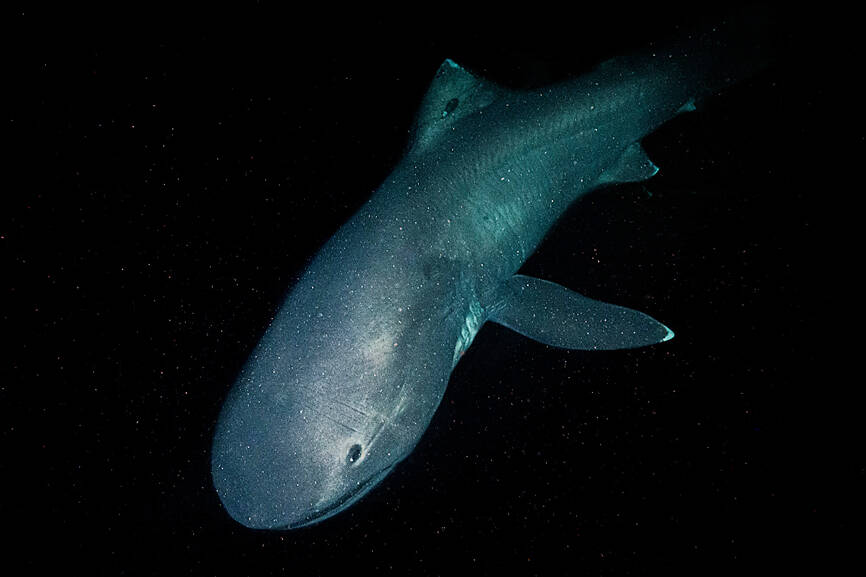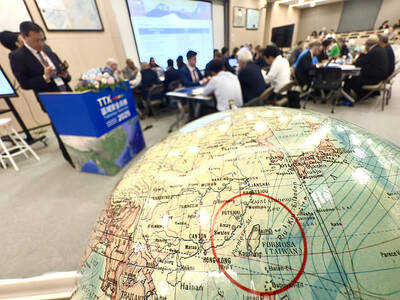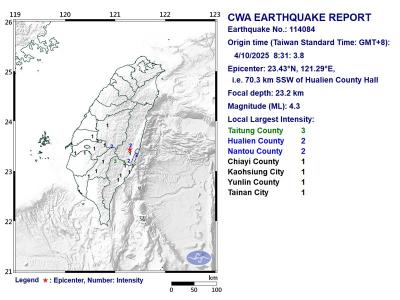Satellite tag technology has facilitated observations of the movement patterns of large fish in waters around Taiwan, the Ocean Conservation Administration (OCA) said on Friday.
The agency said that it has been collaborating with the Fisheries Research Institute since 2021 to track the movements of fish such as megamouth sharks by installing pop-up satellite archival tags on them.
The tags can accurately record the movements of the fish, the depths they swim at and the temperature of the water, it said, adding that when the tags detach, they float to the surface and transmit the data back to the research team via satellite.

Photo courtesy of the Ocean Conservation Administration
Data on 18 fish from nine species have been recorded — three whale sharks, two megamouth sharks, two winghead sharks, two bowmouth guitarfish, a bottlenose wedgefish, two Taiwanese wedgefish, three shortfin mako sharks, a longfin mako shark and two thresher sharks, the OCA said.
The data from the megamouth sharks were especially valuable, as there have been fewer than 300 reported sightings or catches of the species since the first one was discovered in waters off Hawaii in 1976, it said, adding that more than half of the reports were near Taiwan.
The Fisheries Agency in 2020 promulgated a megamouth shark fishing ban, the OCA said.
The data from the tags showed that the two megamouth sharks typically swam at a depth of 400m to 600m in the daytime, and at about 200m at night, it said.
They lead such a “life of two cities” by alternating between deep and shallow waters, probably to catch prey such as krill, it added.
The data showed that the bottlenose wedgefish tended to swim at 7.5m to 42m and in waters of 25.1°C to 28.9°C, while the Taiwanese wedgefish preferred waters no deeper than 28m at temperatures ranging from 26.75°C to 32.25°C, it said.
The data would be used to formulate ocean conservation policies, it added.

DEFENSE: The National Security Bureau promised to expand communication and intelligence cooperation with global partners and enhance its strategic analytical skills China has not only increased military exercises and “gray zone” tactics against Taiwan this year, but also continues to recruit military personnel for espionage, the National Security Bureau (NSB) said yesterday in a report to the Legislative Yuan. The bureau submitted the report ahead of NSB Director-General Tsai Ming-yen’s (蔡明彥) appearance before the Foreign and National Defense Committee today. Last year, the Chinese People’s Liberation Army (PLA) conducted “Joint Sword-2024A and B” military exercises targeting Taiwan and carried out 40 combat readiness patrols, the bureau said. In addition, Chinese military aircraft entered Taiwan’s airspace 3,070 times last year, up about

Taiwan is stepping up plans to create self-sufficient supply chains for combat drones and increase foreign orders from the US to counter China’s numerical superiority, a defense official said on Saturday. Commenting on condition of anonymity, the official said the nation’s armed forces are in agreement with US Admiral Samuel Paparo’s assessment that Taiwan’s military must be prepared to turn the nation’s waters into a “hellscape” for the Chinese People’s Liberation Army (PLA). Paparo, the commander of the US Indo-Pacific Command, reiterated the concept during a Congressional hearing in Washington on Wednesday. He first coined the term in a security conference last

A magnitude 4.3 earthquake struck eastern Taiwan's Hualien County at 8:31am today, according to the Central Weather Administration (CWA). The epicenter of the temblor was located in Hualien County, about 70.3 kilometers south southwest of Hualien County Hall, at a depth of 23.2km, according to the administration. There were no immediate reports of damage resulting from the quake. The earthquake's intensity, which gauges the actual effect of a temblor, was highest in Taitung County, where it measured 3 on Taiwan's 7-tier intensity scale. The quake also measured an intensity of 2 in Hualien and Nantou counties, the CWA said.

The Overseas Community Affairs Council (OCAC) yesterday announced a fundraising campaign to support survivors of the magnitude 7.7 earthquake that struck Myanmar on March 28, with two prayer events scheduled in Taipei and Taichung later this week. “While initial rescue operations have concluded [in Myanmar], many survivors are now facing increasingly difficult living conditions,” OCAC Minister Hsu Chia-ching (徐佳青) told a news conference in Taipei. The fundraising campaign, which runs through May 31, is focused on supporting the reconstruction of damaged overseas compatriot schools, assisting students from Myanmar in Taiwan, and providing essential items, such as drinking water, food and medical supplies,